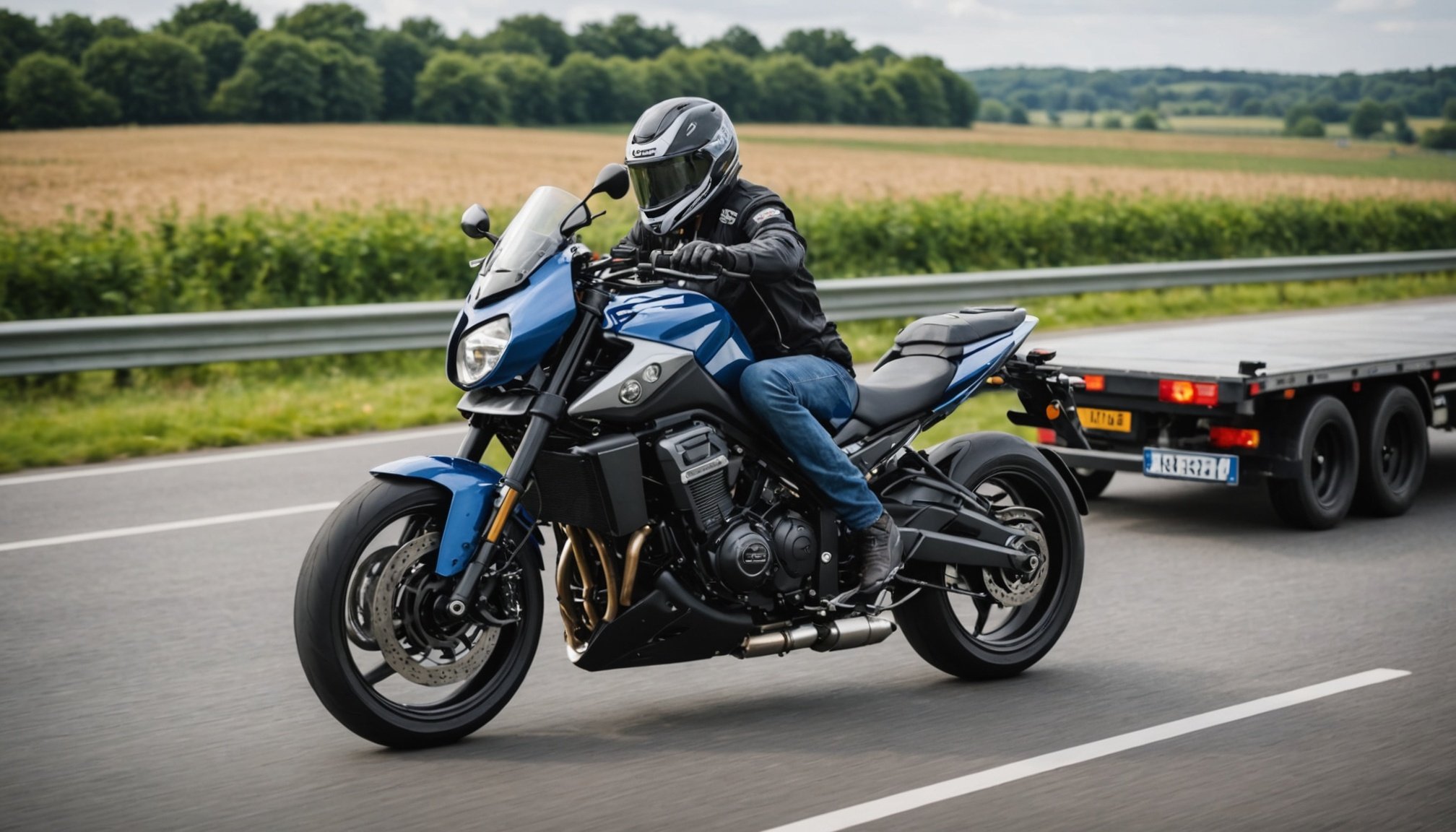Overview of Towing a Sport Bike
Transporting a sport bike can be a daunting task, especially when considering safe bike transportation. Ensuring your bike arrives safely is crucial. Factors like securing the motorcycle on a trailer, weight distribution, and weather conditions need careful consideration. Each of these elements plays a vital role in maintaining the bike’s condition during transport.
In the UK, adherence to motorway regulations is essential when towing a sport bike. Understanding these rules is not just a legal obligation, but also ensures the safety of everyone on the road. Key regulations include adhering to speed limits, securing the bike properly, and ensuring the towing vehicle meets the required specifications. The legal speed limit for vehicles towing a trailer on a UK motorway is 60 mph, for instance. It’s vital to familiarise yourself with these to prevent any legal infractions or accidents.
Also to see : Maximizing Sport Bike Performance: Ideal Engine Configurations for UK Riding Conditions
Amongst the common challenges faced, stability is a major issue. A sport bike is typically larger and heavier than other bikes, which can complicate towing. Balancing the bike securely on the trailer prevents it from tipping over or shifting during transit. Addressing these challenges through proper preparation, diligence, and awareness can make towing a sport bike in the UK a seamless experience.
Legal Requirements for Towing
Understanding UK towing laws is crucial for anyone intending to tow a vehicle. Your driving licence plays a significant role here. For instance, drivers who passed their test before January 1, 1997, have broader privileges, permitting towing vehicles up to 8.25 tonnes combined weight. However, post-January 1997 license holders face stricter conditions, necessitating additional qualifications to tow heavier combinations.
Also to see : Discover the Cutting-Edge Brake Technologies for Sport Bikes: A Guide for UK Enthusiasts
Equally important are the motorcycle towing regulations. Motorcycles can legally tow small trailers, provided they weigh less than 150 kg. Yet, it’s essential to ensure the motorcycle itself is over 125cc and fitted appropriately for towing.
When preparing to tow, registration and insurance obligations must be fulfilled. The towing vehicle needs to be registered and insured, clearly displaying number plates matching the car. Furthermore, obtaining a towing insurance policy is advised to cover potential third-party liabilities and protect you in case of accidents.
Failure to adhere to these legal requirements can lead to severe penalties for non-compliance with UK towing laws. The consequences can include hefty fines and points on your driving licence. Additionally, unlawful towing might void your insurance, leaving you vulnerable to financial and legal repercussions. Always remain informed and compliant to avoid such pitfalls.
Essential Equipment for Towing
Understanding the variety and functionality of towing equipment is crucial for safely transporting your motorcycle. Comprehensive knowledge is particularly important when considering your tractor’s load, the type of bike tow accessories required, and the right selection of a motorcycle trailer.
Types of Tow Trailers
When selecting a trailer, the decision between an enclosed vs. open trailer often hinges on personal preference and specific needs. Enclosed trailers provide superior protection from weather elements and theft, making them ideal for long-distance hauls. However, they tend to be heavier and more costly than their open counterparts, which offer easy loading and unloading while still providing adequate transport security.
When evaluating a motorcycle trailer, consider features like ramp access, braking systems, and hitch compatibility. Sport bike trailers demand careful attention to weight capacities—knowing your sport bike’s weight ensures that your selected trailer can handle the load without compromising safety or performance.
Towing Accessories
Secure your bike with recommended straps and tie-downs. Look for high-strength ratchet straps designed specifically for motorcycles to ensure stability. Safety chains are indispensable, preventing disconnection between your vehicle and trailer. Additionally, essentials like wheel chocks, helmet locks, and anti-rattle devices can enhance towing safety, providing peace of mind on your journey.
Safety Tips for Towing a Sport Bike
Towing a sport bike demands attention and precision. Ensuring the safety of your motorbike begins with understanding the best practices for loading and unloading. Always use a well-fitted ramp, ensuring it’s secured correctly to avoid mishaps and possible injuries. Slowly guide your sport bike up, keeping it aligned and balanced. Once on the trailer, firmly secure it using quality straps designed for motorbike towing.
The importance of weight distribution cannot be overstated. Distribute the bike’s weight evenly across the trailer to maintain balance and ensure smooth maneuverability. Incorrect weight distribution can lead to swaying, making traveling dangerous. It’s crucial to verify that your towing setup can handle the weight of both the trailer and the sport bike.
While on the road, follow simple yet vital tips for driving safely with a motorcycle in tow. Maintain a moderate speed, and always allow extra time for stopping. Keep an eye on the trailer, checking mirrors for stability and any signs of swaying. When turning, take wider routes to accommodate the trailer’s tracking. These precautions ensure that your journey remains safe and your sport bike is unscathed.
Securing Your Sport Bike During Transport
Ensuring your bike security during transport demands meticulous care. Understanding effective motorcycle tie-down techniques is crucial for a safe journey. Let’s delve into ways to optimize tying down and monitoring your sport bike.
Proper Tie-Down Techniques
For effective securement, always use high-quality tie-down straps. Begin by positioning your bike upright. Use a step-by-step guide:
- Attach the straps to sturdy anchor points on both ends of the truck bed.
- Loop the straps through the handlebars or frame, ensuring tightness but avoiding excess pressure.
- Fasten the strap securely, ensuring no slack.
Common mistakes include not distributing tension equally and securing straps around fragile parts. Watching video tutorials or using graphics as visual aids for proper tie-down positioning can clarify techniques.
Monitoring Bike Stability During Transport
Before setting off, perform a thorough check of your loaded bike’s security. Look for any signs of looseness or slipping. This is vital for preventing movement during transit. Conducting periodic checks during long trips helps mitigate risks—examine ties whenever you stop. Noticing signs that the bike may be improperly secured, like tilting or swaying, needs immediate attention. Quickly tighten or reposition as necessary to ensure ongoing safety.
Additional Resources and Further Reading
Navigating the intricacies of motorcycle transport regulations in the UK can be overwhelming. Fortunately, several resources can provide clarity. The official UK government website offers comprehensive guidelines on UK motorcycle laws, including specific towing laws. These sources are invaluable for ensuring compliance and can assist you in avoiding potential legal pitfalls when transporting a motorcycle.
Proper understanding of safety measures is crucial for safe motorcycle transport. For those eager to deepen their knowledge, recommended reading on motorcycle transport safety can offer practical tips and strategies. Books and articles by transport safety experts are particularly useful in understanding how to secure a motorcycle effectively when being towed.
Online forums and communities, such as motorcycle enthusiast groups, present rich platforms for sharing firsthand experiences. Members often discuss best practices and provide recommendations for equipment and techniques that align with current UK motorcycle laws. Such platforms not only offer towing resources but also serve as support networks, facilitating dialogue among like-minded individuals.
These solutions collectively can empower you with the needed expertise to make informed decisions while transporting your motorcycle safely and legally. Engaging with these resources will ensure you’re well-equipped to tackle any challenges that may arise during motorcycle transport.






